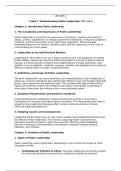LECTURE 1
't Hart's "Understanding Public Leadership" Ch. 1 & 2
Chapter 1: Introducing Public Leadership
1. The Complexity and Importance of Public Leadership
Public leadership is crucial for the governance of societies, involving the ability to
design, protect, supplement, or change governance institutions. It requires judgment,
creativity, and the momentum to act upon those judgments. Effective public
leadership balances the need for decisive action with the awareness of the risks of
concentrating too much power.
2. Leadership as Art and Practical Wisdom
Leadership is often seen as an art, a blend of passion and cool judgment. According
to Max Weber, leadership cannot be effectively taught in a purely academic setting.
Instead, it involves practical wisdom and insights gained through experience. Key
qualities such as empathy, creativity, courage, morality, and judgment are crucial yet
difficult to systematize or explain comprehensively.
3. Definitions and Scope of Public Leadership
The term "leadership" has many definitions and interpretations. Public leadership, in
particular, involves individuals who significantly influence how communities deal with
issues, often beyond formal authority roles. This includes both high-profile political
figures and informal leaders who mobilize and inspire communities. Leadership is
more about interaction and influence than mere positional power.
4. Analytical Perspectives and Research Traditions
Understanding public leadership involves examining it as both a cause and a
consequence of societal and organizational outcomes. This dual perspective helps in
analyzing how leadership strategies affect various contexts and how contexts
influence leadership behaviors.
5. Studying Causes and Consequences
Leadership studies often focus on why certain people reach leadership positions and
the effects of their leadership. This involves analyzing leader characteristics,
behaviors, and the contexts in which they operate. Effective public leadership
requires a thorough understanding of the dynamic interplay between leaders,
followers, and contexts.
Chapter 2: Varieties of Public Leadership
1. Types of Public Leadership
Public leadership varies significantly depending on the context and issues at hand.
Examples include:
Combating Air Pollution in China: Top-down leadership set specific targets
for reducing hazardous microparticles, leading to compliance-oriented
, behavior but also unintended consequences such as business closures and
economic strain on small enterprises.
Celebrity Civic Leadership: Public figures like Angelina Jolie use their
influence to draw attention to global issues, blending fame with advocacy to
effect change.
Moral Leadership in Crises: Individuals like Rosie Batty, who speak out on
personal tragedies like domestic violence, can transform public awareness and
policy.
2. Exercising Public Leadership: The Strategic Triangle
Public leadership involves creating public value through three core strategies:
Public Value Proposition: Articulating a compelling case for what the
leadership aims to achieve.
Operational Capacity: Harnessing resources and behaviors necessary to
deliver public value.
Legitimacy and Support: Securing the necessary authorization and backing
from key stakeholders.
3. Leading Up, Down, and Out for effective leadership
Effective public leaders must navigate complex relationships and influence different
levels of their organization and beyond:
Leading Up: Leading up involves influencing those above the leader in the
organizational hierarchy. This can include superiors, political authorities, and
key decision-makers who have the power to authorize and support the
leader's initiatives: legitimacy, strategic communication, relationship building,
and political navigation.
Leading Down: Leading down refers to guiding, motivating, and managing
subordinates and direct reports. It involves ensuring that the organization or
team is aligned with the leader’s vision and working effectively towards
common goals: Motivating and Inspiring, Providing Direction, Developing Skills
and Creating a Positive Environment.
Leading Out: Leading out involves engaging with external stakeholders,
peers, partners, and the broader community. This is about building coalitions,
partnerships, and networks to achieve broader organizational and societal
goals: collaboration, advocacy, network building, and community engagement
to achieve broader goals.
4. Attention, Commitment, and Influence
Leaders need to allocate their attention wisely, balancing their time and focus
between various demands. Commitment to values and clear communication are
essential for inspiring and guiding their teams. Effective public leadership involves
both hard and soft power, including the use of rhetoric to persuade and mobilize
support.
5. Timing, Patience, and Adaptability
Successful leaders understand the importance of timing and patience. They must
navigate the complex and often slow-moving processes of public policy and
administration, adapting to changing circumstances and building long-term support
for their initiatives.






